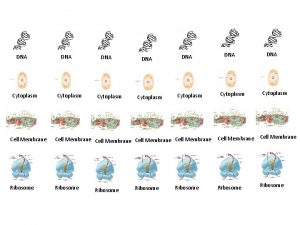Animal cells Part of cell function Cytoplasm A


- Slides: 2

Animal cells Part of cell function Cytoplasm A jelly-like material that contains dissolved nutrients and salts and structures called organelles. It is where many of the chemical reactions happen. Nucleus Contains genetic material, including DNA, which controls the cell’s activities. Cell membrane Mitochondria Ribosomes Its structure is permeable to some substances but not to others. It therefore controls the movement of substances in and out of the cell. Organelles that contain the enzymes for respiration, and where most energy is released in respiration. Tiny structures where protein synthesis occurs Plant cells Specialised cells A root hair cell has a large surface area to absorb more water from the soil by osmosis. Making new cells - mitosis Plant cells also have additional structures: Part of cell Function Chloroplast Organelles that contains the green pigment, chlorophyll, which absorbs light energy for photosynthesis. Contains the enzymes needed for photosynthesis. Cell wall Made from cellulose fibres and strengthens the cell and supports the plant. Permanent vacuole Filled with cell sap to help keep the cell turgid.

Cells revision activities 1. Read the information sheet 2. Answer the key questions 3. Label the plant and animal cell diagrams 4. Answer the exam questions 5. Make a mind map of the cells topic 6. Make keyword cards – put the keyword on one side and the definition on the other side. Test each other. Key Questions 1. Which part of a cell contains the DNA? 2. Where in the cell does respiration occur? 3. What happens in the ribosomes? 4. Name 3 parts that a plant cell has that are not present in animal cells? 5. Does an animal cell have a cell wall? 6. What is the role of the chloroplast? 7. Why is an electron microscope better than a light microscope? 8. What is mitosis? 9. How is a root hair cell adapted to be good at absorbing water? 10. Name the process for water moving into the root.



